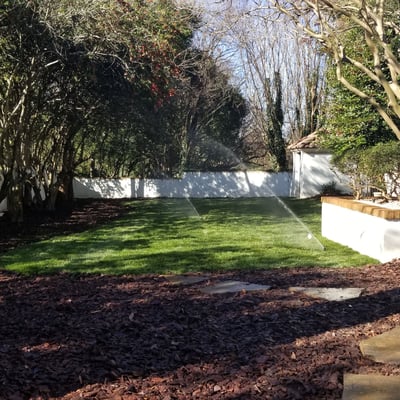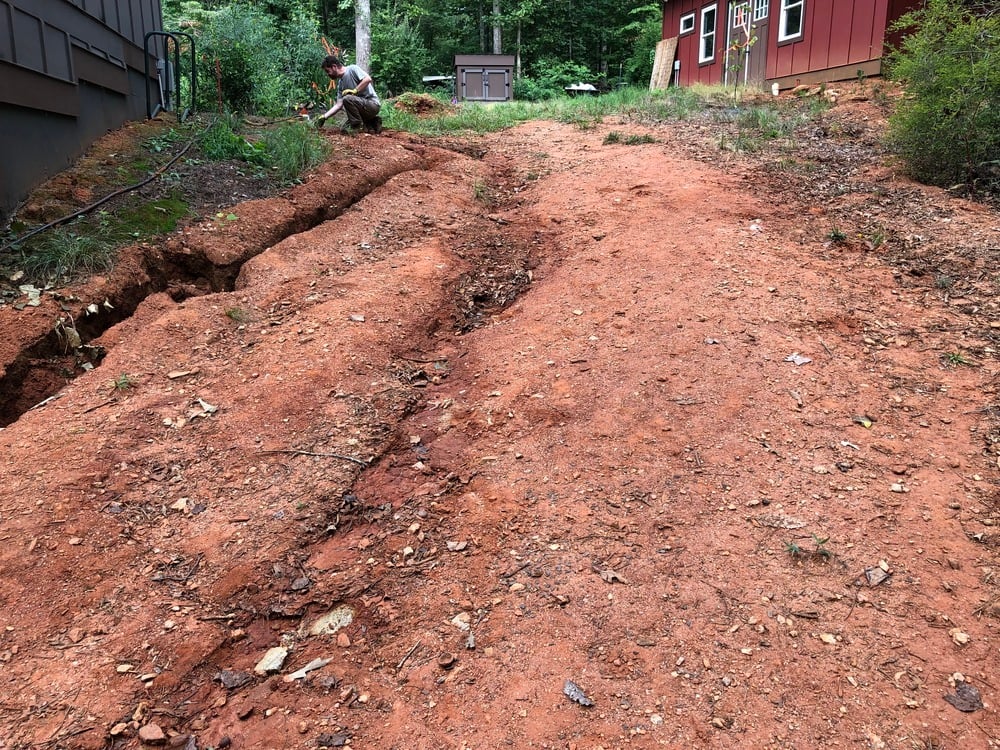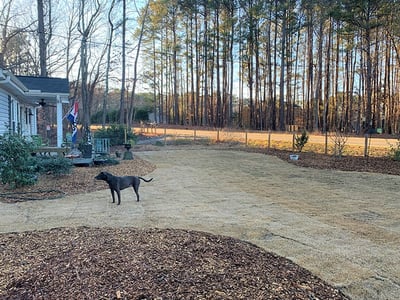

If you find your bare dirt eroding away, the best fix is to lay rolls or pieces of turfgrass sod.
Many people plant grass seed to stabilize eroding, bare dirt, but do you know what happens to seed on a slope in a rainstorm? It flows downhill along with the rain and ends up growing great next to the storm drain.
It’s a bummer to see your grass seed washed away and possibly even germinating along the neighbor’s curb!
Spare yourself the frustration and lay sod on a slope rather than planting grass seed.
If you need to economize by using seed, then use seed for planting flat areas where it won’t wash away. Choose sod for the areas with slopes and save yourself the expense of doing something twice.
10 Reasons Sod Should be Your First Choice for Erosion Control:
- Sod is the Quick Fix: Need to fix erosion in a jiffy? After you address drainage and grading issues, rolls or squares of sod will instantly stabilize the slope. It will secure the slope even before roots are tacked down!
- Sod is a Water Buffer: The leaves, stolons, and rhizomes of turfgrass physically protect bare dirt by dispersing water over a larger area, thus slowing down the rate of water flow and aiding water to infiltrate the soil rather than erode it. Sod does this even before it's rooted in and also when dormant.
- Sod is More Secure: Seed, especially on slopes, gets washed away by rain. It's common to redo planting seed multiple times due to washouts on slopes. Instead, lay your sod perpendicular to the slope and use sod staples. Using those two techniques, new sod will stay in place during rainstorms even before roots have formed.
- Sod Allows for Quicker Occupancy: If you need a certificate of occupancy for a building, you can install sod the day before and still get your CO; if you plant seed you usually have to wait for it to germinate to be granted occupancy.
- Sod is a Permanent Solution: Ryegrass is in most fast-growing seed mixes - but did you know that in the Southeast it dies out in the heat of the summer? Warm season sod (Bermuda, Zoysia, Centipede) and Tall Fescue sod are permanent solutions that won't die out.
- Sod Can be Installed Any Time: Warm season sod (Bermuda, Zoysia, Centipede) can be laid year-round. Yes, you can install dormant warm season sod in winter and it will mitigate erosion even before it comes out of dormancy. Tall Fescue sod can be installed in the cooler months of fall, winter, and early spring.
- Sod is Less Mess #1: Sod instantly blankets bare dirt, thus immediately reducing erosion and mud, making the area cleaner.
- Sod is Less Mess #2: Choose sod and avoid the mess of straw and matting (aka erosion control blankets) left behind. Straw and matting are used to try to keep seed from being washed away on slopes.
- Sod is Instantly Cooling & Walkable: Sod is cool underneath bare feet and can instantly be walked on, even on a slope (carefully). If you plant seed you should stay out of the area until it germinates.
- Sod Saves Money: Save time AND money in the long run by avoiding other solutions that don’t work well on slopes, such as hydroseeding, erosion blankets, and from reseeding multiple times if seed gets washed away.
Pro Tips About Laying Sod on Slopes
- Choose Warm-Season Turfgrasses Because They Have Runners: Warm-season turfgrass sod types such as Bermuda, Centipede, and Zoysia are the best choices for stopping erosion on slopes because they spread via rhizomes and stolons (the runners). These rhizomes and stolons cover and stabilize more area; this trait also allows them to repair themselves if damaged.
Cool-season lawns like Tall Fescue and Ryegrass don't have runners at all, so consider that disadvantage when choosing grass for a slope. - Avoid Turfgrass Seed on Slopes: Earlier, we talked about the disadvantages of seed, and now's a good time to point out that, while warm-season grass from seed WILL develop runners, it takes many months. During the wait, bare earth remains uncovered and is vulnerable to erosion.
- How to Lay Sod on Slopes: Lay sod rolls or pieces perpendicular to the slope to prevent your sod from washing downhill in heavy rainfall. Also, stagger the seams like a brickwork wall - the staggered openings prevent water from channelling down one long seam, building as it goes, and washing away new sod. Staggered, perpendicular rolls and pieces hold up well in a deluge!

Case Study on Sod & Erosion Control
My husband and I planted ryegrass in autumn (bad move per point 5 "Permanent Solution") so we could get our certificate of occupancy and move into our home by Christmas. We made it into our new home in time to celebrate the holiday, but by the end of that summer, the bare soil eroded in deep ruts. We had to rent a skid steer to push the eroded dirt back up the hill to fill in the ruts (living out the reality of point 10 "Save Money").
What happened? The ryegrass died out in the heat, the soil was bare naked, several heavy rains came through, and part of our hillside washed away - right next to the house!
Bare, eroded slope, summer 2019
My husband in the middle, with two helpers, laying sod September 2019
A beautiful lawn, June 2021
Upon laying Zeon Zoysia sod rolls, we were relieved to experience an instant fix.
The lunar landscape created by erosion (per point 7 "Less Mess") was turned into a lush garden, family picnic area, and dog frisbee zone. Plus . . . we were reminded to always do it right the first time.
Special thanks to Paige Diamond, Judson Mills, Greg Nichols, and Kim McQueen for contributing to the list of 10 reasons why sod is the best erosion control.
.png?width=450&name=10%20reasons%20sod%20is%20the%20best%20erosion%20control%20(1).png)






